Think Tank #1 ($3.99, Image)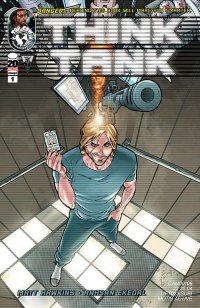
by D.S. Randlett (@dsrandlett)
If Science Fiction’s purpose is to speak truth not only to power, but also to the culture that spawns it, then there is no more fitting subject for the genre’s gaze than the post 9/11 terror surveillance state. There is inspiration aplenty in the actual stories that this context has given fruit to, from unmanned drones to mercenary armies. But examinations of the front lines, while important, are ultimately distant from the roots that give them shape. This may be why critiques of war are tolerated, but critiques of the home front are, if not suppressed, then at least ridiculed. If one must criticize, criticize the expression of destructive power, but not the soul that unleashes it.
Think Tank is ambitious, I’ll give it that. It definitely has a critique to offer on how the Global War on Terror is exercised, and it tries to offer a critique of the apathy and laziness on the home front to really affect any sort of change. The book has a lot on its mind, and it tries to walk a fine line. Although Think Tank is nonetheless admirable in its ambition, it is not entirely successful.
For one, its mix of civilian and military life as presented in the book’s principal character fails to establish a clear theme. He is Dr. David Loren, PhD. He’s a mixture of tropes that are by now entirely all too familiar. The boy genius who grew up to be a brilliant slacker, who knows everything about his subject, but all too little about himself. Series writer Matt Hawkins has written some obvious room for growth here, which is something of a problem. Loren’s arc is obvious, even if it hasn’t played out yet. There are some pretty major stirrings of his conscience in this first issue, as it forms the basis of what appears to be developing into a high octane and high concept man on the run romp.
But back to theme. Loren is something of an Archimedes type here, a kept genius of the United States military who can seemingly conjure ways to execute their vision for war machinery through will alone. Where it stumbles is in giving Loren a bleeding heart, which Archimedes did not have. What Archimedes had was his subject, and there have been many men like him who were so all consumed with solving the puzzles in front of them that they had no concept of their further moral complications (take the time to google Fritz Haber). In Think Tank, it is as if Archimedes knew the implications of his war machinery and wanted out of his arrangement with the King of Syracuse. To be fair, the book does treat this aspect of the character a bit, but only cursorily. Think Tank has a lot of fingers to point, and justly so, but its desire for Loren to be the one who’s right and pointing the finger holds the book back from really exploring some of the most interesting issues surrounding GWOT culture. If Archimedes only cared about math and physics, where does that leave those of us who care only for security? This is not a question that is on this book’s lips.
But then, Think Tank is a very good comic book. It’s held back by a fair number of genre conventions, but it is written and drawn with such verve and care that it’s hard not to get sucked into its world. Even though there isn’t any action, artist Rahsan Ekedal draws every scene as if it were one. The rather lengthy scenes of dialog and exposition manage to crackle, and the scenes of Loren’s machines doing their work manages to be both striking and startling.
For all that I leaned into the writing earlier for what it isn’t, what it is is very clever and fresh. For a comic book that seeks to explore some very serious issues, Think Tank can be very brisk, wry, and genuinely funny. Loren is a smartass genius archetype, but Hawkins’ writing pulls that act off rather well.
Think Tank is well worth picking up, but like so many of Image’s other high concept Sci Fi titles from the past year, I find myself wishing that it pushed a little bit harder and dug a bit deeper.
Rating: 




Out of a Possible 5 Stars
 Beasts of Burdern: Neighborhood Watch One-Shot (Dark Horse,$3.50)
Beasts of Burdern: Neighborhood Watch One-Shot (Dark Horse,$3.50)
by Graig Kent
Of late I’ve taken an interest in discerning what it is that makes the comics I read so special, in particular to the medium, whether it be the execution of a story, the artistic flourishes that couldn’t be replicated in any other form, the scope of storytelling or any of dozens of other nuances that makes the comic books so unique.
With Evan Dorkin and Jill Thompson’s Beasts of Burden, it’s the creator-driven element that can’t be replicated quite the same way outside the structure of sequential art. Over their creation’s short and sporadic life, Dorkin and Thompson have primarily told short stories or done-in-one tales (including a Hellboy crossover), a storytelling structure that television or movies couldn’t support, especially given that the series only continues at the whims of its creators. At the same time, it’s a series that features talking animals taking on genuinely creepy situations, a typically G-rated conceit juxtaposed against a hard PG-13-rated genre. Again, something that’s not ready-made for most other formats.
Through a trilogy of short stories, this one-shot continues to explore the mysteries and metaphysics of the small town and paranormal epicenter of Burden Hill, as well as extrapolating upon the relationships between the dogs and cats who serve as it secret protectors and expanding the concept and history of animal protectors. Their “people” seem completely oblivious to the threats that the brave canines and felines ward off, and equally unaware of the legacy that they carry forth.
Where previous Beasts stories were severely eerie, these three tales take a more whimsical turn, which may be Dorkin’s natural comedic sensibilities poking through. But Thompson’s ridiculously gorgeous painted art retains the subtle sense of permanent gloom that hangs over Burden Hill, while still capturing the spirit of the story Dorkin’s written with the expressiveness in her animals, which despite their formidable feats, retain a naturalness and true-to-reality appearance.
The thing about Beasts of Burden, despite what I said above about it being so unique to comics, is that it is a creator-driven product. As such I could easily see Dorkin and Thompson releasing an illustrated chapterbook (much as Mignola has done with Christopher Golden on Hellboy), a younger reader storybook, or even a motion comic for the Geek and Sundry youtube channel. Frankly, I think Beasts of Burden would make a rather dramatic feature length CGI film in the Pixar vein, maturely told, kid-accessible. Yet it does require fully the involvement of Dorkin and Thompson, who seem to derive great pleasure in returning to Burden Hill and so obviously hold nothing back in investing in their creation.
Rating: 




Out of a Possible 5 Stars
Hawkeye #1 (Marvel, $3.99)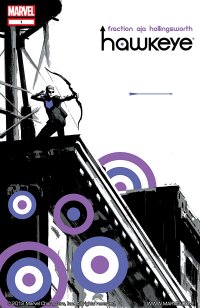
By Jeb D.
My favorite comic in many months opens with a great joke: Hawkeye, his body posed dramatically, is falling out of a shattered window, poised to launch an arrow with some fancy device to pull him out of his fall: a scene right out of the Avengers movie. But, instead of a dramatic Jeremy Renner move, artist David Aja slams our hero up against the side of the building, and lands with a sickening crunch on a car, breaking bones, nearly rupturing his spleen, and being told by a doctor that he was lucky to get off so easy. Funny? Well, yeah, it is… in part because, on his way down, Clint Barton was musing on the near-insanity of his position as a non-powered member of a team of titans and gods, and the near-inevitability of the life he’s chosen being pretty much the equivalent of slamming into that car over and over again; in just a few panels, writer Matt Fraction gives Clint a marvelous sense of the absurd, that serves to ground him in more ways than the gravitational.
Fraction and Aja (along with Ed Brubaker) were responsible for one of the most amazing transformations I can recall in many years of reading comics: turning the generic Kung Fu knockoff Iron Fist into a fantastical pulp adventure, with a rich supporting cast and a graphic look that was light-years removed from the spandex gloss typical of a Big 2 book. They’re at it again. I don’t know that Hawkeye was in quite as dire need of a makeover as Iron Fist was (Hawkeye’s got a much longer history of writers doing interesting things with him), but in Fraction and Aja’s hands, he’s been rethought and reimagined in ways that feel unexpected, but wholly right.
There’s a variety of formulas for creating the hero in an action/detective/superhero/police story, but one that always seems to work is the mashup of Joe Friday with Philip Marlowe: the cool professionalism of the seasoned pro leavened with the knight-errant’s willingness to apply that experience on behalf of those powerless to help themselves. Fraction has set Clint Barton (who is out of uniform for the rest of the issue after that opening) in a well-realized Bedford-Stuyesvant environment, and uses a rooftop cookout to give quick introductions to a supporting cast that Aja manages to make distinct and believable: Clint’s neighbors know who and what he is, and his level of comfort with them, and theirs with him, is a nice change from the typical secret-identity melodrama.
Naturally, it’s trouble for those he cares about that gets Clint into action, and the villains’ plot has a nicely contemporary ring: the criminals who own the tenements are using their (entirely legal) right to triple the rent to drive the working-class tenants out so they can sell off the properties for a big windfall. Fraction’s conception of the baddies is an amusing gloss on the familiar stereotype Eastern European mobster, and Clint’s encounters with them are full of witty grace notes, but without undercutting the sense of menace, or the desperation of an all-too-realistic portrayal of the sort of villainy that real people too often find themselves helpless before. And Fraction wastes no time on having his hero agonize over the ambiguity of legal niceties: law or no law, it’s wrong, and that’s enough for Clint, whose wry characterization keeps things from getting sentimental. That’s most noticeable during the sequences intercut through the book of Clint insisting on medical help for a dog who’s been hit by a car: I won’t spoil how and why it’s so important for him to help the poor creature, but Fraction and Aja use these sections as an effective mirror on Clint’s own story.
At this point, I don’t know how to lavish more praise on Aja than he accumulated for Iron Fist, but he complements Fraction perfectly, with things like the time-shifting of the sequences with the dog; the imaginative paneling of the rooftop cookout; and just the way he has Clint deliver a threat, leaning casually on the side of a car, one of dozens of small moments where Fraction trusts Aja to perfectly convey character beats. Like all great comics, Hawkeye #1 is a constantly surprising sequence of expertly-captured moments.
I suppose if I wanted to quibble, I could say that this nicely self-contained first issue doesn’t really do much to set up a long-range storyline for the series… but I don’t want to. In fact, screw that—here, my friends, is that modern desiderata of the superhero genre: the perfectly-paced and executed done-in-one story. If the succeeding issues are anywhere near this good, this’ll give Daredevil a strong run for its money as Marvel’s best superhero book.
Rating: 




Out of a Possible 5 Stars
 Harvest #1 ($2.99, Image)
Harvest #1 ($2.99, Image)
by D.S. Randlett (@dsrandlett)
You will want to shower after reading this.
I’m not kidding, this has to be one of the dirtiest, goriest comics that I’ve read in the past year. In terms of detail and quality, the art by Justin Lorimer is top notch, reminiscent of the work of someone like Tim Bradstreet, complete with an ever present threatening sense of darkness and shadow. More than that, he really captures the grimy nature of this story about a desperate screw up doctor who turns to farming organs for the Yakuza. Depictions of medical gore don’t usually get to me, but here it just feels so wrong an malevolent thanks to Lorimer’s art. A lot of first issues fail to really make a visceral impression, but this does in a big way, and for that I have to give it some points.
Unfortunately, the writing doesn’t leave as much of an impression. A.J. Lieberman’s script is adequate to the task of conveying the essential information, but as of the first issue of this limited series there is very little connection to any of the characters. Granted, Lieberman has to walk a fine line here between a compelling sense of mystery and presenting enough of the characters for them to draw the reader in, and so far this story is pretty thin on themes. Lieberman errs a little too heavily on the side of mystery, to the point that I felt like I had nothing to really grab onto besides my interest in the art and the basic plot.
Harvest is absolutely worth picking up for what it gets right, though. To say anything more would be to spoil much of what makes this book so surprising, shocking, and genuinely fun.
Rating: 




Out of a Possible 5 Stars
Daredevil by Mark Waid Vol. 1 tpb (Marvel, $15.99)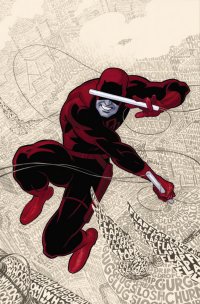
by Graig Kent
I was never a huge Daredevil fan. My first exposure was a pocketbook-sized, black-and-white collection of a couple of the Man Without Fear’s early tales, bought in a thrift shop whilst on vacation back in, I would guess, 1982 or ’83 (I bought a Clubber Lang action figure from the Rocky 3 line in the same store at the time I do recall). In its first story Daredevil fought the Eel, the Ox and some other guy in a mask, still in his yellow-and-red costume (I only knew it was yellow and red because of the painted cover image). In the second story, DD was in his newfangled red duds (which I knew were red, because I was already aware of who DD was by then) and took on Stilt Man. As a DC aficionado well into my late teens, only ever dipping a toe into the Mavel pool, this minimal exposure early on to Daredevil actually only made me a Stilt Man fan, less so Matt Murdock. I tuned into Daredevil at perhaps his worst period, in the mid-1990’s when Marvel was copycatting all of DC’s big events and thrusting Daredevil into a decidedly Azbats looking new armored suit.
It wasn’t until Daredevil was re-birthed under the Marvel Knights banner that I started to pay attention, primarily because it was Kevin Smith’s first major foray into comics and i was a huge Kevin Smith devotee for about a decade. I picked up Smith’s “Guardian Devil” tpb in a discount bin at some con, and then proceeded to buy, in sporadic, haphazard fashion, the subsequent trades from Brian Michael Bendis, Alexander Maleev and David Mack. I wasn’t in love with DD from Smith’s story, but I was certainly amenable to reading more. Of course, since I bought the majority of the trades out of order it was years, deep into the first decade of the new Millennium, before I finally sat down and read Bendis and Maleev’s epic run. I was so enamored with what I read that I thought myself a big DD convert, and quickly searched out the Frank Miller trades, having heard the legend of that run which had built up over the years.
The legend however did the series no favors, and Miller’s stories did not hold up under the weight of what was told. With Ed Brubaker and Michael Lark taking over for Bendis and Maleev, I found my affection for the character slipping. Brubaker did a solid job of trying to deal with the fallout of the havoc Bendis had wrought upon Matt Murdock’s life, but it just didn’t sustain the same level of intensity or fascination. I was tapped out by the end of Brubaker’s run, and, in hindsight, am quite content with my decision to skip Andy Diggle’s “posessed-by-a-Demon” storyline (even though I generally like Diggle’s work).
Mark Waid I’ve actively liked for over two decades now. I’m rarely disappointed with his work, and even though I’m not a devotee, he is a draw for me. But Waid wasn’t the immediate sell for me to return to the pages of Daredevil. It’s one image, that cover image from issue number 1 (that also graces this TPB collection) by Paolo Rivera, an incredibly striking design of the red-suited Daredevil, eyes blocked by his own baton, against a sepia toned backdrop of a cityscape rendered completely in onomatopoeia. It’s brilliant, it’s gorgeous and one of the most incredible superhero images in recent memory. I was hooked at first sight and awaited the trade with bated breath for well over a year now.
The book is a drastic deviation from the character that we’ve seen since 1998. The grimness has faded, not completely, but the overall sensibility is that this is a new chapter, one more high-spirited and adventuresome, less with the drama, trauma and other noir-ish tendencies that preceded it. Waid seems keen on putting DD back into the Marvel universe, mainly through introducing familiar villains, and perhaps a cameo from a costumed Avenger or two. In no way has Waid avoided Murdock’s recently troubled past, and in fact addresses it head-on, continuously. The wringer that Bendis and company put DD through are a constant driving factor in the stories and life of the blind lawyer. It’s the tonal shift in both the character and style of story, with Murdock at least putting on the air of happy-go-lucky, even if he doesn’t really have the reality to back that up. His alter ego is still semi-exposed, and not fading from memory fast enough for his liking, and it’s Waid’s handling of this particular dilemma that’s a major source of the entertainment within the book. He derives much humour from Matt and Foggy fending off accusations of superheroing, pointing out the obvious folly in the logic of a blind lawyer being a costumed vigilante, and yet Murdock still plays a little fast and loose with his secret identity.
Waid establishes a new status quo for Murdock’s personal, professional and recreational life quickly, creating a potential love interest and a whole new angle for his lawyering that still allows Waid to play with the conventions of television legal dramas without having to invest too much time in the courtroom. It’s a book heavily concerned with evenly mixing both character development and entertainment value and delivers on both.
The art from the alternating team of Paolo Rivera and Marcos Martin is uniformly solid and the two artist’s styles are quite complimentary, making for a smooth transition between the two. I prefer Rivera’s work more as it’s more dynamic in execution and his representation of DD’s sonar powers is amazing. It’s a good starting point for any non-DD fan, light but involving.
Rating: 




Out of a Possible 5 Stars
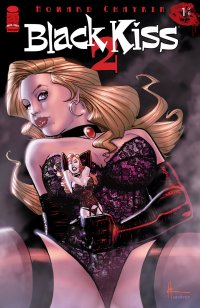 BLACK KISS 2 #1 of 6 (Image, $2.99)
BLACK KISS 2 #1 of 6 (Image, $2.99)
By Jeb D.
How does that old Woody Allen joke go… the shrink asks “Do you think sex is dirty?”, and Woody responds, “It is if you’re doing it right.”
That’s a pretty good summation of the weirdly puritanical relation that horror novels, movies, and comics have always had to the mechanics of human species propogation: nothing signals trouble for a character in a spooky story more than making the beast with two backs (or one and a half, depending on your inclinations); the uglier the better. And no one in comics has had more fun rutting in that particular muck than Howard Chaykin. Whether American Flagg!, The Shadow, or the original Black Kiss series, he’s cheerfully equated sexual exploitation with personal, political, and corporate malfeasance of all types: no sex act (literal or metaphoric) comes without cost (literal or metaphoric); any ecstasy to be had comes in the form of power and dominance.
Chaykin’s first Black Kiss series set its visually-explicit sexual power games into a plot involving a transgendered hooker, dirty secrets of old Hollywood, the Vatican, the Mob, and vampires. And while it was a bit easier to be shocking to comics readers back in the 80’s, even today, the original Black Kiss would wind up being stocked in the Adults-Only section of most shops. But Chaykin clearly believes that, like a shark, the concept of epater le bourgeoisie has to keep moving forward or die, so this latest edition opens with a sexual encounter that may be even more grotesquely debased than anything he’s come up with in the past; the fact that it’s debatable which of the participants is the one doing the exploiting is vintage Chaykin. This first issue splits its time between 1906 New York City (upon which Chaykin exhausts a veritable thesaurus of synonyms for “dirty”) and the ill-fated voyage of the Titanic; Manhattan moviegoers fall under the rapacious spell of some sexually Lovecraftian tentacles, while the doomed greedheads on the ship are entertaining the charms of a devilish succubus.
Black and white linework has always been Chaykin at his best: without thick layers of ink and color, his characters are less blocky, his action more fluid. Black Kiss 2 makes excellent use of its period settings, actually rendering redundant much of its more purplishly-descriptive narration (and there’s a LOT of it).
I can’t exactly recommend Black Kiss 2 (or 1, for that matter) in any general way: if you don’t buy into Chaykin’s perversely sullied worldview, you may find this comic exploitive in all the wrong ways. Problem is, apart from the shock value, Chaykin simply can’t shut up enough to let his art tell the story, so there’s little of the sense of creepy discovery that the best horror storytelling provides; everything’s signposted in big, screaming letters. It’s best thought of as a more or less direct pipeline to the id of one of comics’ most important veterans: if the latest chapter of the career of Howard Chaykin is a priority for you, Black Kiss 2 is a must; the casual horror fan may find the whole thing a bit too obvious.
Rating: 




Out of a Possible 5 Stars
The First X-Men #1 (Marvel, $3.99)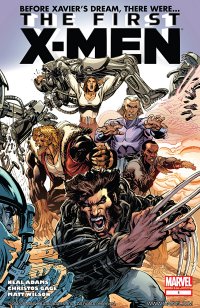
By Jeb D.
The response to Neal Adams’ return to comics has been… well, politely muted, particularly when you consider that, unlike some of his peers, he wasn’t put out to pasture, but pretty much turned his back on the field, deciding there was more creativity (and a lot better money) in “grownup” commercial art. Given that, you’d have assumed that his motivation to return to what was a four-color comics world when he left it would be evident in some storytelling freshness, or visual innovation. That wasn’t the case when he reacquainted himself with Batman recently, and it’s emphatically not the case with his reunion with Xavier’s crew. Well, unless you equate freshness with doing whatever the fuck you want to with an established franchise.
Christos Gage is listed as co-writer, but I’m guessing he just came aboard to polish dialogue, since Adams as writer-artist has clearly laid out the plot, such as it is. I’ve never been much of a continuity maven, but I honestly have no idea what version of the X-Men Adams thinks he’s writing here: it seems to cobble together contradictory bits from Lee and Kirby, Claremont/Cockrum/Byrne, Morrison, the Ultimate Universe, and the intermittently wonky timelines of the X-Men / Wolverine / First Class films, while coming up with a few baffling wrinkles of his own. At some vague time in the past, Xavier’s still in school, but he’s already bald (and a bit of a self-hating asshole); Sabretooth and a bone-clawed Wolverine are bickering adversaries/buddies, and are already listed among the established targets for teams of high-tech hunters of the many mutants who are evidently already “well-known to the police,” as the saying goes. Wolverine, it turns out, is not the taciturn loner we’d always imagined, but a touchy-feely group-hug type who is the one that turned Xavier into the high-minded protector of mutantkind; imagine that. Or, better, don’t. Again, the issue isn’t continuity, but character: if there exists a version of X history where Xavier’s personality does a complete 180, prompted and abetted by a talky, uber-empathetic version of Logan, it didn’t come out of any edition of the Handbook of the Marvel Universe; more likely, it came from Adams grabbing bits of things he remembers from his bygone days with the X-Men, a cursory viewing of a couple of the movies, and deciding that no one reading the book would give a fuck anyway. I know that the whole work-for-hire situation has been the source of a lot of bad treatment of industry pros over the years, but that doesn’t change the fact that the popularity of characters like the X-Men (the popularity that allows someone like Adams to get well-paid for writing and drawing them) rests with a readership that appreciates, if not strict continuity, then at the very least some consistency: if Adams wants to start over with something like “Next Men,” then more power to him. But if he wants to play with the Marvel toys, he needs to share.
Artistically, this is immediately recognizable as a Neal Adams book (the wild looks of astonishment, the use of posture and body perspective to convey emotion), and the draftsmanship and paneling are impeccable: they’re also the sort of thing he was doing in his sleep thirty years ago, and doesn’t appear to have awakened since; again, nothing about the look of the book suggests that drawing comics was getting his juices flowing again, or that he had new ideas to explore. It’s just the latest collector’s artifact for the Neal Adams completist. He didn’t become a legend by repeating himself, but by challenging himself, and us. Only challenge he faces here is getting another four bucks out of me next time.
Rating: 




Out of a Possible 5 Stars